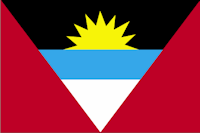Antigua & Barbuda - Climate
 The hurricane season in Antigua and Barbuda normally runs from June to November. The country has very low annual rainfall (40–42 inches), with droughts occurring every three to seven years. It has no rivers and very few streams. Two desalination plants supply roughly 70% of the water; other sources include surface water and wells. Barbuda depends heavily on underground wells for its water supply. In 2007, 89.3% of the population had access to safe drinking water and 72.9% had access to improved sanitation facilities; the 22.7% of the population considered to live in poor quality housing relied on pit latrines or even more rudimentary sanitation facilities.
The hurricane season in Antigua and Barbuda normally runs from June to November. The country has very low annual rainfall (40–42 inches), with droughts occurring every three to seven years. It has no rivers and very few streams. Two desalination plants supply roughly 70% of the water; other sources include surface water and wells. Barbuda depends heavily on underground wells for its water supply. In 2007, 89.3% of the population had access to safe drinking water and 72.9% had access to improved sanitation facilities; the 22.7% of the population considered to live in poor quality housing relied on pit latrines or even more rudimentary sanitation facilities.
Hurricane Earl in 2010 and Hurricane Omar in 2008 affected the country. Hurricane Omar damaged and destroyed homes and caused flooding. The estimated cost of reconstruction and other activities related to Hurricane Earl was US$ 12,767,922; costs related to Hurricane Omar were US$ 210,000.
Antigua and Barbuda is a small island developing state and is susceptible to sea level rise; air- and sea-surface temperature increases; more frequent and more severe hurricanes; and changes in rainfall patterns. These vulnerabilities will severely affect the tourism and food production sectors. Adaptation efforts to the new or changing environment were under way, including improving disaster response capabilities, establishing an institutional base for handling climate change, and implementing an integrated water management plan.
Antigua and Barbuda is already experiencing some of the effects of climate variability and change through damage from severe weather systems and other extreme events, as well as more subtle changes in temperature and rainfall patterns. Climate change effects are evident in the decline of some coastal tourism resources, but also in the socioeconomic sectors which support tourism, such as agriculture, water resources, health and biodiversity.
One meter and two meter sea level rise [SLR] scenarios, and beach erosion scenarios of 50 m and 100 m, were used to assess the potential vulnerability of major tourism resources. Results of surveys indicate that 1 m SLR places 10% of the major tourism properties at risk, along with 2% of road networks and 100% of sea ports. With 2 m SLR, 18% of major tourism resorts will be impacted and 100% of airports. Critical beach assets will be affected much earlier than SLR-induced erosion damages to infrastructure; indeed, once erosion is damaging infrastructure, it means the beach, a vital tourism asset, has essentially disappeared.
Annual reductions in the contribution of tourism to Antigua and Barbuda’s national GDP as a result of the reduced amenity value from beach loss is estimated to be between US $102 million in 2050 to over US $340 million in 2080 (based on a mid-range SLR scenario). The costs of rebuilding the infrastructure are estimated to be over US $668 million in 2050, up to US $1.57 billion in 2080 for tourism resorts and an additional US $19 million by 2050 to US $46 million by 2080 for re-building ports and $1 million in 2050 to $2 million by 2080 for major roadways.
The agriculture sector is highly vulnerable to climate related events and low annual rainfall and high evaporation and transpiration rates make irrigation necessary for sustained yields and moderate levels of production, especially in drought years. January to April 2010 brought severe drought conditions which contributed to substantial crop losses. This was followed by excessive rainfall from April to August causing soil saturation and leaching which hampered land preparation and resulted in retarded crop growth.
|
NEWSLETTER
|
| Join the GlobalSecurity.org mailing list |
|
|
|

